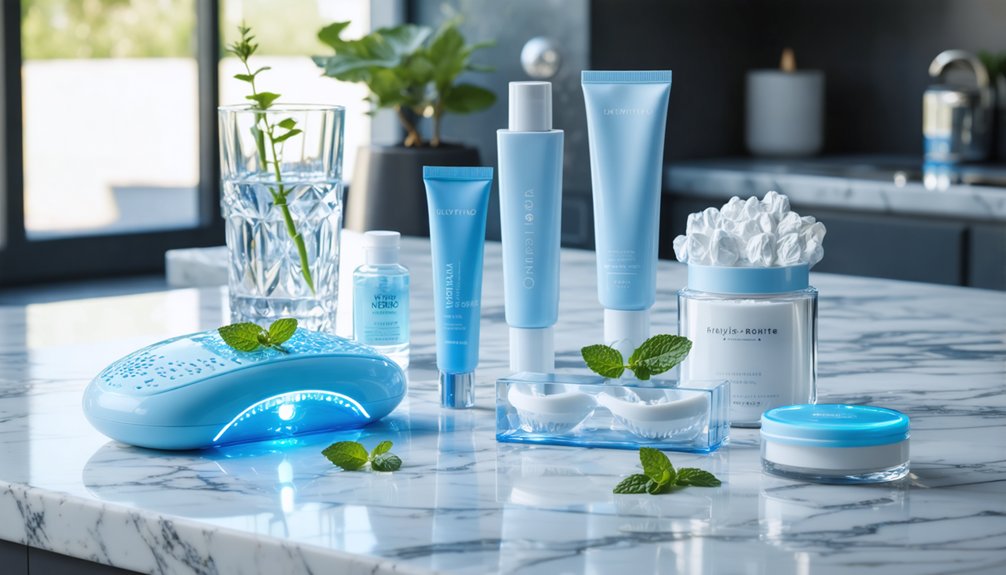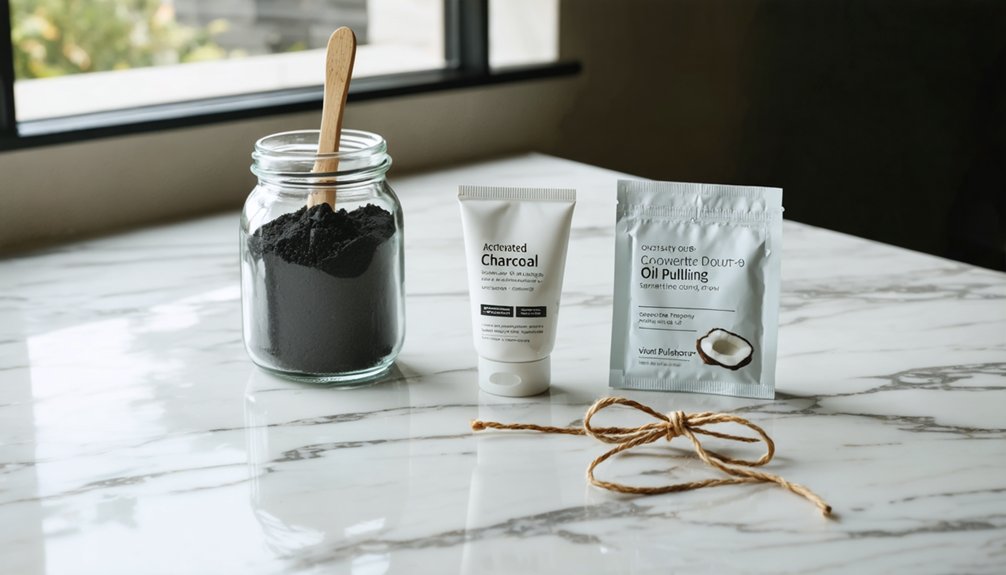You can effectively manage teeth sensitivity during whitening by selecting gentle products with lower peroxide concentrations (10-16%), using desensitizing toothpaste 2 weeks before treatment, avoiding temperature extremes in foods and drinks, maintaining a sensitivity-safe diet rich in calcium and phosphates, and following proper post-treatment protocols like waiting 2-3 hours before brushing. These evidence-based strategies can reduce whitening discomfort by up to 80% when implemented correctly.
Key Takeaways
- Use gentle whitening products with lower concentrations and custom trays to minimize sensitivity while achieving desired results.
- Start using desensitizing toothpaste two weeks before treatment and continue throughout the whitening process.
- Avoid hot and cold foods during treatment, sticking to room temperature items to prevent tooth discomfort.
- Maintain a sensitivity-safe diet rich in calcium and phosphates while avoiding acidic and highly pigmented foods.
- Wait several hours before brushing after treatment and use soft-bristled brushes with desensitizing toothpaste.
Choose Gentle Whitening Products and Methods
When pursuing teeth whitening treatment, selecting gentle products and methods is essential for managing sensitivity while achieving desired results.
Choose teeth whitening products that prioritize comfort and sensitivity management – your smile can brighten safely and effectively.
Consider natural alternatives like baking soda and enzymatic cleaners that avoid peroxide-based formulations, which commonly trigger discomfort. These options provide gradual whitening while minimizing structural stress on your enamel.
Custom trays offer superior control during the whitening process, as they’re precisely molded to your teeth’s anatomy.
You’ll benefit from using lower-concentration gels over extended periods, reducing sensitivity risks compared to high-concentration treatments. The perfect fit prevents gel leakage onto gums, while allowing precise application of desensitizing agents before and after sessions.
When recommending treatment options to patients, prioritize LED whitening systems with adjustable intensity levels, as their cool blue light accelerates results without generating uncomfortable heat. Professional supervision during whitening treatment helps minimize adverse effects and ensures safe application.
Potassium nitrate and fluoride in desensitizing gels can help minimize discomfort during whitening treatments.
Start Using Desensitizing Toothpaste Early
A proactive approach to sensitivity management requires starting desensitizing toothpaste at least 1-2 weeks before your whitening procedure. The early application allows active ingredients like potassium nitrate and strontium chloride to create a cumulative effect by blocking exposed dentin tubules and calming nerve endings. Consistent daily use is essential for maximum sensitivity protection.
This preemptive strategy proves highly effective for both 22% carbamide peroxide home treatments and 35% hydrogen peroxide in-office procedures. Most patients experience mild ache sensations during the initial stages of whitening treatment.
You’ll need to continue using the toothpaste daily throughout your whitening process and afterward, depending on your sensitivity level. The compounds work by occluding microscopic tubules and depolarizing nerve endings, greatly reducing your sensitivity window from the typical 24-72 hours.
When combined with professional fluoride treatments, you’ll maximize enamel protection and guarantee ideal comfort during whitening.
Avoid Hot and Cold Foods During Treatment
Since teeth whitening temporarily opens microscopic dentin tubules, consuming foods and beverages at extreme temperatures can trigger intense sensitivity and discomfort.
For optimal results, stick to soft, bland foods during treatment to minimize irritation while maintaining proper nutrition.
Effective temperature management and smart food choices during the first 24-48 hours post-treatment are essential for minimizing sensitivity and protecting your newly whitened teeth.
Using whitening toothpaste regularly helps maintain results while reducing sensitivity during the treatment period.
- Maintain all beverages and foods at room temperature or lukewarm (avoid items below 45°F or above 120°F)
- Wait 30 minutes post-consumption before brushing to allow enamel re-hardening
- Rinse with room temperature water after eating or drinking to neutralize oral pH
- Replace hot coffee, tea, and cold beverages with lukewarm alternatives during your treatment period
If you experience persistent sensitivity to temperature variations beyond 48 hours, contact your dental professional for additional guidance.
Maintain a Sensitivity-Safe Diet
Following teeth whitening treatment, maintaining a sensitivity-safe diet becomes essential for ideal results and comfort management.
Focus on consuming room-temperature dairy products, including plain yogurt and milk, which provide calcium and phosphates for enamel strengthening. Your dietary adjustments should incorporate lean proteins like skinless chicken and egg whites, along with light-colored fruits and vegetables. Opt for crunchy white cauliflower as it naturally helps clean teeth while providing essential antioxidants.
For best sensitivity considerations, you’ll need to avoid acidic foods, highly pigmented beverages, and rough-textured items that could irritate your enamel. The first 48 hours are most critical for protecting your newly whitened teeth from staining and discoloration.
Instead, choose soft, easy-to-chew options and maintain proper hydration with water or clear broths at room temperature. These choices support remineralization while preventing further sensitivity and staining.
Remember that nutrient-rich foods containing calcium, phosphates, and vitamins D and K actively contribute to your enamel’s recovery process.
Follow Smart Post-Treatment Care Steps
To minimize discomfort after teeth whitening procedures, implement thorough post-treatment care within the first 48 hours.
Your enamel’s protective pellicle layer needs time to regenerate, making proper post-treatment protocols essential for ideal recovery and sensitivity reduction.
- Wait 2-3 hours before brushing teeth, then use only soft-bristled brushes with gentle motions to prevent mechanical irritation.
- Apply desensitizing toothpaste containing hydroxyapatite or fluoride consistently for at least two weeks.
- Maintain post-treatment hydration with room temperature water while avoiding hot, cold, or acidic beverages. Expect mild thermal sensitivity that typically resolves within 24 hours.
- Use pH-balancing rinses to neutralize acidic residues and support enamel protection.
Using a fluoride mouthwash can help strengthen your enamel and provide additional protection against sensitivity.
Consider keeping NSAIDs on hand for acute sensitivity, and consult your dental professional if prolonged discomfort occurs.
Frequently Asked Questions
How Long Does Whitening-Induced Tooth Sensitivity Typically Last?
You’ll experience whitening-induced sensitivity duration of 24-72 hours, though it can extend up to one week. Proper post-whitening care greatly reduces discomfort as your enamel naturally remineralizes.
Can I Continue Using My Electric Toothbrush During Teeth Whitening Treatment?
You can safely use your electric toothbrush during whitening treatments, but select sensitive mode, use soft bristles, and follow pressure guidelines to protect your enamel and minimize sensitivity during the process.
Does Smoking Affect Tooth Sensitivity During the Whitening Process?
Clinical data shows smoking doesn’t markedly affect tooth sensitivity during whitening treatments, with smokers and nonsmokers experiencing similar sensitivity rates of 47%. However, you’ll need specialized sensitivity management due to compromised enamel health.
Are Natural Whitening Methods Less Likely to Cause Tooth Sensitivity?
Patiently pursuing purely natural remedies won’t prevent painful sensitivity. You’ll still risk enamel damage from acidic or abrasive ingredients, while professional treatments offer controlled formulas with sensitivity prevention safeguards.
Should I Postpone Whitening if I Have Existing Dental Work?
You should postpone whitening if you have existing dental work, as bleaching agents won’t affect restorations. Consult your dentist first to evaluate sensitivity concerns and develop a plan for uniform coloration.
References
- https://familydentistchandler.com/how-to-avoid-teeth-sensitivity-after-whitening/
- https://myvallejodentist.com/2024/06/27/how-to-reduce-tooth-sensitivity-during-whitening-treatment/
- https://www.goodrx.com/conditions/dental-care/sensitive-teeth-after-whitening
- https://www.scottgreenhalghdds.com/blog/10-tips-for-dealing-with-sensitivity-after-teeth-whitening
- https://www.sensodyne.com/en-us/oral-health-tips/whitening-sensitive-teeth/how-to-help-sensitive-teeth-after-whitening/
- https://www.colgate.com/en-us/oral-health/tooth-sensitivity/managing-sensitive-teeth-after-whitening
- https://www.360dentalgroup.com/2021/06/25/strategies-to-cope-with-teeth-whitening-pain/
- https://mathewdds.com/blog/unbearable-pain-after-tooth-whitening/
- https://www.advancedsmilesmarion.com/resources/best-teeth-whitening-technology
- https://gentledental.interdent.com/resources/teeth-whitening-methods-pros-cons



